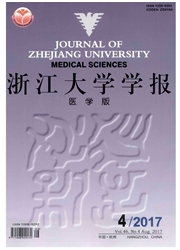

 中文摘要:
中文摘要:
目的:本研究旨在探讨既往抗血小板药物使用对合并颅内微出血患者静脉溶栓后发生出血转化以及预后的影响。方法:连续分析2009年6月至2015年6月期间在浙江大学医学院附属第二医院神经内科接受重组组织型纤溶酶原激活剂静脉溶栓治疗的急性缺血性卒中患者临床资料,纳入溶栓前行磁敏感序列检查的患者,收集其既往抗血小板药物使用记录;根据ECASSII标准评估溶栓后出血转化情况,随访3个月改良Rankin量表(mRS)评分。结果:最终纳入分析449例患者,平均年龄(66.8±12.9)岁,女性151例(33.6%),男性298例(66.4%),发病至溶栓时间为(229.0±103.7)min,溶栓前美国国立卫生研究院卒中量表评分为10(5-15)分;共172例(38.3%)合并颅内微出血,63例(14.0%)既往使用抗血小板药物。Logistic回归分析提示,既往抗血小板药物治疗不增加合并颅内微出血患者静脉溶栓后血肿型出血转化风险(OR=0.809;95%CI:0.201。3.262:P=0.766),也不增加其3个月神经功能结局不良(mRS≥3)的比例(OR=1.517:95%CI:O.504—4.568;P=0.459)。而对于合并多发微出血(i〉3)的患者,既往使用抗血小板药物增加其梗死外出血转化风险(OR=9.737;95%CI:1.364。69.494;P:0.023),但对神经功能结局无显著影响(OR=1.697:95%CI:0.275。10.487;P=0.569)。结论:目前没有证据显示需要将既往抗血小板药物使用作为合并颅内微出血患者静脉溶栓的禁忌,而合并多发颅内微出血的患者需要更大样本的研究。
 英文摘要:
英文摘要:
Objective: To evaluate the safety of intravenous thrombolysis (IVT) in cerebral microbleeds (CMBs) patients with prior antiplatelet therapy. Methods: Four hundred and forty nine patients with acute ischemic stroke aged (66.8 ± 12.9) years, including 298 males and 151 females, underwent susceptibility-weighted imaging (SWI) examination and MRI-guided IVT therapy between June 2009 and June 2015. The presence of CMBs, previous antiplatelet therapy, HT subtypes according to ECASS II criteria and functional outcome based on modified Rankin scale (mRS) at 3 months were analyzed in logistic regression model. Results: Total 934 CMBs were detected in 172 (38.3%) patients, among whom 63 ( 14.0% ) previously received antiplatelet therapy. All patients received intravenous recombinant tissue-plasminogen activator (rt- PA) for thrombolysis with the onset-to needle time of (229.0 ± 103.7) rain. The pretreatment National Institutes of Health Stroke Scale (NIHSS) score was 10 (IQR 5- 15). Logistic regression analysis indicated that prior antiplatelet use increased neither risk of parenchymal hematoma (PH) ( OR = 0. 809,95% CI:0. 201 - 3. 262, P =0. 766) nor adverse functional outcome ( OR = 1. 517, 95% CI:0. 504 - 4. 568, P = 0. 459) in patients with CMBs; while in patients with multiple CMBs ( ≥13 ) prior antiplatelet use increased risk of hemorrhagic transformation ( OR = 9.737, 95% CI: 1. 364 -69. 494, P =0. 023), but not adverse functional outcome ( OR = 1. 697, 95% CI:0.275 -10.487, P =0.569). Conclusion: The study indicates that in patients with CMBs, thrombolytic therapy should not be excluded due to the prior use of antiplatelet; however, the larger prospective studies are needed in future for patients with multiple CMBs.
 同期刊论文项目
同期刊论文项目
 同项目期刊论文
同项目期刊论文
 Evaluation of Brain Iron Content Based on Magnetic Resonance Imaging (MRI): Comparison among Phase V
Evaluation of Brain Iron Content Based on Magnetic Resonance Imaging (MRI): Comparison among Phase V Extensive cerebral microbleeds predict parenchymal haemorrhage and poor outcome after intravenous th
Extensive cerebral microbleeds predict parenchymal haemorrhage and poor outcome after intravenous th Rosiglitazone attenuates hyperglycemia-enhanced hemorrhagic transformation after transient focal isc
Rosiglitazone attenuates hyperglycemia-enhanced hemorrhagic transformation after transient focal isc Morphology of susceptibility vessel sign predicts middle cerebral artery recanalization after intrav
Morphology of susceptibility vessel sign predicts middle cerebral artery recanalization after intrav No Hemorrhagic Transformation after Intravenous Thrombolysis in a Pontine Infarction Patient with Ba
No Hemorrhagic Transformation after Intravenous Thrombolysis in a Pontine Infarction Patient with Ba Statin Withdrawal Beyond Acute Phase Affected Outcome of Thrombolytic Stroke Patients An Observation
Statin Withdrawal Beyond Acute Phase Affected Outcome of Thrombolytic Stroke Patients An Observation Different risk factors for poor outcome between patients with positive and negative susceptibility v
Different risk factors for poor outcome between patients with positive and negative susceptibility v 期刊信息
期刊信息
